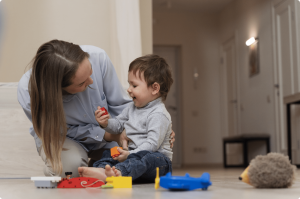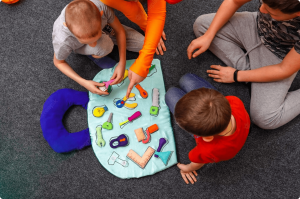Young children are supposed to learn with all their senses. The world is supposed to be their classroom, and us adults, their teachers. The correlation between children’s development and sensory toys is their ability to help kids develop better life skills through play, with the help of their five senses.
Until they form a personality around the ages of 3 and 5, their caregivers – as well as their little hands, noses, ears, eyes, and tongues – will be their guides.
In their first years they can’t ask for something; so they’ll point to it. They’ll show interest in a certain object, so they’ll grab it. They’ll even try to put whatever that thing is in their mouth, until we hurry up and say they’re not supposed to do that. But that’s all part of the process. That’s a fantastic representation of the exploratory nature children should develop when trying to decode the environment.
Play is a child’s most important daily occupation (1). We may refer to it as “play”, but it’s far more than just fun. Although fun makes it engaging, play is essential work that contributes to all areas of a child’s life – cognitive, physical, language, social, and emotional.
There’s no better way to a child’s healthy cognitive development than through rich sensory experiences. It isn’t laborious nor expensive to provide your children with the most enlightening toys they can, quite literally, get their hands on.
As a few examples, here are a few sensory toys parents and caregivers may have readily available in their homes:
- Clay
- Play dough
- Building blocks
- Busy cubes
- Puzzles
- Busy books
- Colouring books
All they need is a paradigm shift in order to understand that those toys belong in their child’s hands, rather than being an obsolete version of a digital application. Encouraging the use of sensory toys and the play derived from them continues to be the wisest way to raise children.
How Sensory Play Raises Curious, Smart, and Confident Children
Sensory Play Contributes to Cognitive Development
The developmental importance of sensory toys is strongly supported by research, which registers the role of play in the growth of children across all domains (2).
By age 3, a child has developed from 50 trillion synapses in their brain. Sensory stimulation through toys helps grow and develop these synapses which, in turn, aids their cognitive development.
They may progress in this development by acquiring essential skills through sensory play. Some of these skills involve:
- Fine motor skills. Skills that contribute to small hand movements, like turning a book page and grabbing something using their fingers.
- Eye-hand coordination. Refers to the coordinated control of eyes and hands in activities like colouring , dot connecting, and puzzles.
- Communication skills. Skills that involve asking, talking while playing, as well as saying “please” and “thank you”.
- Spatial skills. Refers to one’s awareness of the spatial differences and relations among objects, like building blocks.
It Fosters Creativity, Imagination, and Out-Of-the-Box Thinking
Can a toy dragon speak? Can single building blocks be stacked up, one on top of another, in order to create a tower? Can a nondescript piece of play dough become anything a child wants it to be?
Yes, they can. Most importantly, they should.
The act of associating toy objects to different things and characters is essential to the development of a creative, imaginative mind. Importantly, creativity is directly tied to the development of essential problem-solving skills. An inventive mind encourages unconventional thinking, the breaking of barriers, and self-discovery. For this reason, children who have this skill sharpened throughout their early years may have certain advantages in their personal and professional lives.
It’s worth mentioning that sensory play reinforces a child’s language development and social-emotional development when done as a group activity. Let’s dive further into that.
It Encourages Healthy Interactions With Parents, Caregivers, and Peers
When a child plays with someone else, be it their mother, father, nanny, or classmate, they’re learning vital social and communication skills: turn-taking, saying “please” and “thank you”, sharing, as well as learning to behave in a social environment.
Whether it’s in their home, the classroom, or the playground, collective play with sensory toys provides rich language experiences for every single child involved. Although there’s a time and place for solitary play, it shouldn’t substitute peer-child or parent-child interactions during playtime. There’s a wealth of skills to be learned through group play, especially sensory play, which only human-to-tiny-human interaction can offer.
Sensory Play Reinforces the Importance of Physical Toys
If smart devices such as phones and tablets are overstimulating for adults, imagine what they can be to a child in development.
For children, screen-based pastimes will mostly hinder the essential peer-child and parent-child interactions mentioned earlier. When a child is playing with an app, the only existing interaction is between them and the device. There will be tactile experiences, sounds, and colours – but all artificial. There won’t be human interaction, turn-taking, or tangible benefit to them.
In truth, there isn’t enough supporting evidence that proves the need for children to “graduate” to electronic toys. There’s no scientific proof that smart devices and electronic toys are essential for the healthy development of infants and toddlers. In fact, electronic toys by themselves fail to provide children with the necessary interaction engagement that are critical for healthy development (2).
Can Children With Special Needs Benefit From Sensory Play?
It’s common for children with developmental delays or disabilities to encounter certain restrictions when it comes to play. Factors such as intellectual limitations and/or physical restrictions could be restrictive to their development.
Certain processing difficulties may contribute to a less enthusiastic approach to intrinsically fun games and activities. Such difficulties include less socially interactive play, a decreased ability to play, and less active play (2).
As such, sensory activities are beneficial to the cognitive advancement of special needs children. According to Disability Grants, the engagement of children with autism spectrum disorders (ASD) in sensory activities is favourable in a number of ways, as it:
- May be helpful in brain stimulation.
- Helps in creating neural pathways.
- Improves a child’s sensory processing systems.
- Improves social and communication skills.
Stimulating the five senses sends signals to children’s brains, which help strengthen neural pathways important for all types of learning (3). However, it’s important to note that there should be adaptation of toys to accommodate a motor, visual, or other disability for children with special needs (2).
Sensory Toys are More Fun (and Educational) When Shared
“The most educational toy is one that fosters interactions between caregivers and children in supportive, unconditional play.” (2)
Any parent or caregiver who wants children to grow up to be smarter, creative problem solvers should count on the skill-building capability of sensory toys. Plus, it’s essential for adults to encourage peer interaction whenever possible, as well as actively participate in children’s sensory activities.
Sensory toys, as exemplified in the beginning of this article, should promote learning and growth in all areas of a child’s development. Ideally, you should select toys that will spark a child’s creativity and imagination, promote healthy interactions with parents and other children, as well as nurture their enthusiasm for continuous exploration and problem-solving.
- Watts, Tara & Stagnitti, Karen & Brown, Ted. (2014). Relationship Between Play and Sensory Processing: A Systematic Review. The American journal of occupational therapy : official publication of the American Occupational Therapy Association. 68. e37-46. 10.5014/ajot.2014.009787.
- Healey A, Mendelsohn A; COUNCIL ON EARLY CHILDHOOD. Selecting Appropriate Toys for Young Children in the Digital Era. Pediatrics. 2019 Jan;143(1):e20183348. doi: 10.1542/peds.2018-3348. Epub 2018 Dec 3. PMID: 30509931.
- Gainsley, Suzanne. “Look, Listen, Touch, Feel, Taste: The Importance of Sensory Play.” HighScope, Volume 25, no 5, 2011.





